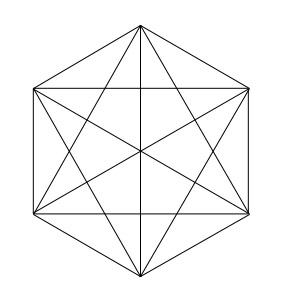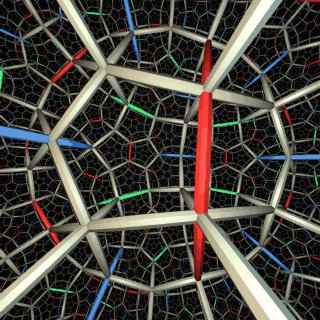Over the last year I have formulated a number of separate ideas. These include; my work on Direct Relativity, quantum gravity, black hole singularities, Layer Cake Theory, 4-dimensional domain grid space (O'Neill space) and others. Recently, while trying to unify some of these ideas I came across some inaccuracies in my previous statements. I will try to outline my new theory while hopefully correcting some of these inaccuracies as I go.
First of all if you have read my articles on 4D domains (O'Neill Space), or Layer Cake Theory, you will know that I have been attempting to unify the concept of Relativity with that of Quantum Mechanics for some time now.
Lets just take O'Neill Space for a start. This is the concept that ordinary 3-dimensional grids can be rotated to create 4-dimensional grid domains. These new domains show us, that from our perspective at least, there is no difference between the 4th dimension (time), which is a spatial dimension, and the minute realm of the quantum world. That sounds like a bold statement, and I almost cringe writing it, but that is just the way it appears to me when I try to look at this information.
What this means is that a craft accelerating through space at light speed would enter into the fourth dimension, the region of space whose interaction with 3d space creates the impression of time, and simultaneously would also be crossing the divide into the strange world of quantum mechanics.
How can this be?
Well, for a start. Any massive object that under goes considerable acceleration undergoes a length contraction, known as a Lorentz contraction, which is equivalent to a foreshortening in 4d space-time. At fully light speed this contraction (foreshortening) is infinite, meaning that the object has been compressed along one axis down to the quantum spatial level. It would appear that the other axes would extend into the 4th dimension, so very little of the craft would appear to exist from our world view; having entered into the realm of the past or future.
So, at light speed, the craft appears to have undergone such a strange manifestation as to allow it to become, for all intents and purposes, some kind of quantum particle.
Here, we start to blur the lines of something that should be rather basic in science. Namely, the notion of scale and perspective i.e. the difference between something being small and something being far away. It would appear that, on a cosmological scale, there is no difference. The reason why quantum particles appear so small is because they are actually located at extreme distances somewhere along the 4th dimension. This is actually not contested among most quantum physicists.
Where things start to get weird is when we apply this same notion to our accelerating space craft. When the spaceship accelerates away from us, it naturally gets smaller - this is perspective - but it is also breaking through the quantum barrier, which means that it is also getting smaller by under going a dimensional/scale contraction. We might think that these two effects should compound each other to produce a really rapid contraction, but actually they don't because they are the same effect. That is really mind boggling: Wait a moment until you get your head around that one.
Lets put the above in the language of Direct Relativity and see how we can clear it up and begin to see it from a 'Grand Unified' perspective. This will also give me a chance to revise some of the points I made in previous articles.
Lets go back to our tesseract, which serves as our representation of 4d timespace. Imagine that the cube located at the centre of the tesseract is ordinary 3D space. The cube that is adjacent to it, to the left, is distorted to the same degree that we would expect our spaceship to be distorted when traveling at the speed of light i.e. it is Lorentz contracted. Because this cube is angled at ninety degrees to our own universe and distorted into 4d space, we will only be able to perceive a fraction of what is going on there. If we continue this rotation by another 45º, which is equivalent to accelerating it another one half the speed of light - meaning that the object is now traveling 1.5 times the speed of light - the object becomes completely flat from a multiple of perspectives.
Lets go back to how this relates to the quantum world. It would appear that the distorted cube relates to the quantum world of particles and waves, whereas the rotated and flattened cube relates to the Plank Limit. Once the tesseract is rotated a final 45º, a rotation equivalent to twice the speed of light, it flips entirely into an area of the fourth dimension which is out of reach to us.
It is difficult to say what this area corresponds to, although it would appear that spacetime is actually the result of two separate and completely alike dimensions (Universes) interacting. Time is the bleed between these two domains, or the result of some kind of communication between the two of them.
When we travel at light speed, we travel along the node or conduit which bridges these two universes. But when we completely exceed the boundary of either Universe, which for us is the Plank Scale, we enter into one or the other.
Now lets look at the whole thing for a completely different perspective. Here our 3D universe is represented by the cube that surrounds the tesseract and stretches off into infinity in every direction. This is a concept that we are more familiar with. Ordinary matter appears solid up to the boundary of the tesseract, after which we enter into the Lorentz contracted space of the quantum world. The boundary of the inner-cube represents the Plank Limit and the inner-cube itself represents the space of this postulated other dimension.
When traveling at the speed of light an object begins to orientate into the 4th dimension and, as a result, catches up with the flow of time itself causing it to stand still. Obviously, this means that time is the result of space expanding into the 4th dimension. However, it should be pointed out that this expansion is bubbling up from the quantum realm and is therefore coming from the 4th dimension to begin with.
As I have stated before, space is not really expanding at all it is merely rotating in 4D space. This explains why when a moment is gone, its gone. We cannot recapture the past because the region of space-time that is associated with it has slipped beyond the event horizon and into the 4th dimension.





































